1. Tiskaya M, Al-Eesa NA, Wong FS, Hill RG. Characterization of the bioactivity of two commercial composites. Dent Mater. 2019; 35:1757–1768. PMID:
31699444.
2. Jefferies SR, Fuller AE, Boston DW. Preliminary evidence that bioactive cements occlude artificial marginal gaps. J Esthet Restor Dent. 2015; 27:155–166. PMID:
25640821.
3. Lai G, Li M. Secondary caries. Li MY, editor. Contemporary approach to dental caries. Rijeka, Croatia: InTech;2012.
4. Cenci MS, Pereira-Cenci T, Cury JA, Ten Cate JM. Relationship between gap size and dentine secondary caries formation assessed in a microcosm biofilm model. Caries Res. 2009; 43:97–102. PMID:
19321986.
5. Vallittu PK, Boccaccini AR, Hupa L, Watts DC. Bioactive dental materials-Do they exist and what does bioactivity mean? Dent Mater. 2018; 34:693–694. PMID:
29571660.
6. Gandolfi MG, Taddei P, Tinti A, Dorigo ED, Prati C. Alpha-TCP improves the apatite-formation ability of calcium-silicate hydraulic cement soaked in phosphate solutions. Mater Sci Eng C. 2011; 31:1412–1422.
7. Ruengrungsom C, Burrow MF, Parashos P, Palamara JE. Evaluation of F, Ca, and P release and microhardness of eleven ion-leaching restorative materials and the recharge efficacy using a new Ca/P containing fluoride varnish. J Dent. 2020; 102:103474. PMID:
32941973.
8. Gandolfi MG, Ciapetti G, Taddei P, Perut F, Tinti A, Cardoso MV, et al. Apatite formation on bioactive calcium-silicate cements for dentistry affects surface topography and human marrow stromal cells proliferation. Dent Mater. 2010; 26:974–992. PMID:
20655582.
9. Fuss M, Wicht MJ, Attin T, Derman SH, Noack MJ. Protective buffering capacity of restorative dental materials
in vitro
. J Adhes Dent. 2017; 19:177–183. PMID:
28443832.
10. Kirsten GA, Rached RN, Mazur RF, Vieira S, Souza EM. Effect of open-sandwich vs. adhesive restorative techniques on enamel and dentine demineralization: an in situ study. J Dent. 2013; 41:872–880. PMID:
23851134.
11. Kirsten GA, Takahashi MK, Rached RN, Giannini M, Souza EM. Microhardness of dentin underneath fluoride-releasing adhesive systems subjected to cariogenic challenge and fluoride therapy. J Dent. 2010; 38:460–468. PMID:
20193726.
12. Al-Harbi F, Kaisarly D, Michna A, ArRejaie A, Bader D, El Gezawi M. Cervical interfacial bonding effectiveness of class II bulk versus incremental fill resin composite restorations. Oper Dent. 2015; 40:622–635. PMID:
26151459.
13. Irie M, Suzuki K, Watts DC. Delayed polishing technique on glass–ionomer restorations. Jpn Dent Sci Rev. 2009; 45:14–22.
14. Magura ME, Kafrawy AH, Brown CE Jr, Newton CW. Human saliva coronal microleakage in obturated root canals: an
in vitro study. J Endod. 1991; 17:324–331. PMID:
1779218.
15. Moheet IA, Luddin N, Ab Rahman I, Masudi SM, Kannan TP, Nik Abd Ghani NR. Analysis of ionic-exchange of selected elements between novel nano-hydroxyapatite-silica added glass ionomer cement and natural teeth. Polymers (Basel). 2021; 13:3504. PMID:
34685263.
16. Thakur AK, Srivastava N, Chakrabarty T, Rebary B, Patidar R, Sanghavi RJ, et al. An improved protocol for electrodialytic desalination yielding mineral-balanced potable water. Desalination. 2014; 335:96–101.
17. Parirokh M, Askarifard S, Mansouri S, Haghdoost AA, Raoof M, Torabinejad M. Effect of phosphate buffer saline on coronal leakage of mineral trioxide aggregate. J Oral Sci. 2009; 51:187–191. PMID:
19550085.
18. Han L, Okiji T, Okawa S. Morphological and chemical analysis of different precipitates on mineral trioxide aggregate immersed in different fluids. Dent Mater J. 2010; 29:512–517. PMID:
20823620.
19. Zain S, Davis GR, Hill R, Anderson P, Baysan A. Mineral exchange within restorative materials following incomplete carious lesion removal using 3D non-destructive XMT subtraction methodology. J Dent. 2020; 99:103389. PMID:
32492503.
20. Chun K, Choi H, Lee J. Comparison of mechanical property and role between enamel and dentin in the human teeth. J Dent Biomech. 2014; 5:1758736014520809. PMID:
24550998.
21. Nicholson JW. Glass ionomer dental cements: update. Mater Technol. 2010; 25:8–13.
22. Ngo H, Mount GJ, Peters MC. A study of glass-ionomer cement and its interface with enamel and dentin using a low-temperature, high-resolution scanning electron microscopic technique. Quintessence Int. 1997; 28:63–69. PMID:
10332357.
23. Sauro S, Makeeva I, Faus-Matoses V, Foschi F, Giovarruscio M, Maciel Pires P, et al. Effects of ions-releasing restorative materials on the dentine bonding longevity of modern universal adhesives after load-cycle and prolonged artificial saliva aging. Materials (Basel). 2019; 12:722. PMID:
30832247.
24. Tay FR, Pashley DH, Suh B, Carvalho R, Miller M. Single-step, self-etch adhesives behave as permeable membranes after polymerization. Part I. Bond strength and morphologic evidence. Am J Dent. 2004; 17:271–278. PMID:
15478490.
25. Itthagarun A, Tay FR, Pashley DH, Wefel JS, García-Godoy F, Wei SH. Single-step, self-etch adhesives behave as permeable membranes after polymerization. Part III. Evidence from fluid conductance and artificial caries inhibition. Am J Dent. 2004; 17:394–400. PMID:
15724748.
26. Gonçalves LL, Da Silva TM, Prakki A, Barcellos DC, Caneppele TM, De Oliveira HP, et al. Universal adhesive: the effect of different simulated pulpal pressure fluids and bonding modes to dentin. Odontology. 2022; 110:62–69. PMID:
34213683.
27. Chen C, Niu LN, Xie H, Zhang ZY, Zhou LQ, Jiao K, et al. Bonding of universal adhesives to dentine--old wine in new bottles? J Dent. 2015; 43:525–536. PMID:
25797702.
28. Cruz J, Silva A, Eira R, Sousa B, Lopes M, Cavalheiro A. Dentin permeability and nanoleakage of universal adhesives in etch-and-rinse vs self-etch modes. Oper Dent. 2021; 46:293–305. PMID:
34424991.
29. Pires PM, Neves AA, Makeeva IM, Schwendicke F, Faus-Matoses V, Yoshihara K, et al. Contemporary restorative ion-releasing materials: current status, interfacial properties and operative approaches. Br Dent J. 2020; 229:450–458. PMID:
33037365.
30. Yamamoto H, Iwami Y, Unezaki T, Tomii Y, Ebisu S. Fluoride uptake in human teeth from fluoride-releasing restorative material
in vivo and
in vitro: two-dimensional mapping by EPMA-WDX. Caries Res. 2001; 35:111–115. PMID:
11275670.
31. Wiegand A, Buchalla W, Attin T. Review on fluoride-releasing restorative materials--fluoride release and uptake characteristics, antibacterial activity and influence on caries formation. Dent Mater. 2007; 23:343–362. PMID:
16616773.
32. Gašperšič D. Enamel microhardness and histological features of composite enamel pearls of different size. J Oral Pathol Med. 1995; 24:153–158. PMID:
7783004.
33. Jang JH, Lee MG, Ferracane JL, Davis H, Bae HE, Choi D, et al. Effect of bioactive glass-containing resin composite on dentin remineralization. J Dent. 2018; 75:58–64. PMID:
29807059.













 PDF
PDF Citation
Citation Print
Print




 XML Download
XML Download